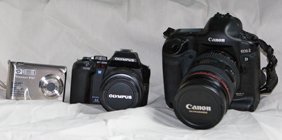Introducing Digital SLR Cameras
| What makes a camera a digital SLR, anyway? And how is it different than a point-and-shoot camera? If you're familiar with film cameras, then you know that SLR stands for single lens reflex, a system which uses mirrors and lenses to capture an image. When a photographer looks through a lens on an SLR camera, the image he sees enters the camera, hits a mirror, and then bounces through a prism onto a focusing screen. Just before the shutter is snapped, the mirror swings out of the way to expose the image onto a piece of film. With an SLR, the photographer sees exactly what the camera sees. Digital SLRs work in the same way, although the image is captured by a digital image sensor instead of film. Like film, the sensor in your digital camera is sensitive to light; it records the amount of light that hits its surface when the shutter is opened. Color is achieved by a filter that's placed over each pixel on the sensor. In a digital camera, the union of pixel and its filter is called a photosite. Figure 1.1 shows how a filter grid looks. Figure 1.1. A digital sensor is composed of millions of photosites, also called pixels, which collect light during an exposure. Circuitry then converts this light into image data that becomes a digital photo at the end of the process.
Point-and-shoot digital cameras, also called digicams, are simpler in design than dSLRs, and their smaller sensors and photosites put limitations on image quality. The most obvious distinction between the two camera types is that lenses on dSLRs are interchangeable, just like with their film cousins, whereas digicams sport a single lens that's affixed to the body. The ability to exchange lenses depending on the situation or artistic intent makes dSLR cameras much more versatile than digicams (Figure 1.2). Figure 1.2. From lightweight entry-level up to large pro-level bodies, there's a digital SLR suited for nearly every budget and need.
One differentiating factor is becoming increasingly important: the ability to shoot in the raw format (see Chapter 7). Point-and-shoot cameras only produce JPEG images, which go through some processing and compression, saving space on the memory card. Images captured in their native raw format more accurately reflect the colors we see through the lens. That's because digicams producing JPEG files have to convert image data to RGB (red/green/blue, the colors that digital images mix to produce all colors) before it can be processed with an image-editing application on the computer. The conversion process discards data, which can compromise the quality of the image. Raw images, on the other hand, retain all the image data, so the photographer has greater latitude as well as control when editing images. When you're ready to make the leap to a digital SLR, it's time to think about which camera to buy. You'll find a huge range of options with the digital SLR market, from simple-to-use, compact camera bodies up through pro-level cameras with advanced features (and price tags to match). The first step in your journey is to decide what your budget is and what features are most important to you. |
EAN: 2147483647
Pages: 91

